Remember when the Nokia 3310 felt like the coolest thing on the planet? Now your smartphone is more powerful than the computer that sent people to the Moon. The same transformation is happening on factory floors, only this time, the stakes are much higher.
The first industrial revolution gave us steam engines. The second brought electricity and assembly lines. The third introduced computers to manufacturing. And today, we’re living in the era of the fourth revolution: digital twins, artificial intelligence, and the Internet of Things are turning ordinary factories into something that feels straight out of Star Trek’s Enterprise.
Modern manufacturers face massive challenges: customers want personalized products yesterday, regulators demand zero emissions, and competitors are breathing down their necks. In this race, winners are those who aren’t afraid to invest in smart IT solutions for manufacturing industry.
The right manufacturing software solutions become that magic wand that helps businesses stay afloat, and even outpace their rivals.
Table of Contents
ToggleWhat’s Broken: The Reality of Modern Manufacturing
If manufacturing problems could be solved with a simple reboot, we’d live in a different world. But reality is harsher than Dark Souls on maximum difficulty.
First, legacy ERP systems. They work with the reliability of a Swiss watch, if you’re living in 2005. Try connecting modern IoT sensors to them, and you’ll see a fireworks display of incompatibility that would put any New Year’s celebration to shame.
Second, data is scattered everywhere, like Infinity Stones before Thanos decided to collect them. The production department keeps its spreadsheets, quality has its reports, logistics lives in a parallel universe altogether. The result? Nobody can calculate the real losses from line downtime.
Third, the shortage of qualified specialists. Experienced engineers are retiring, taking with them knowledge that was never documented. Young professionals want to work with modern technology, not equipment from the Cold War era.
Add to this the energy crisis, ESG requirements, and supply chain problems after COVID-19. The pandemic showed just how fragile global manufacturing networks are. One factory in China shuts down, and suddenly you have no chips for cars across all of Europe.
That’s why IT solutions for manufacturing have become not a luxury, but a matter of survival.
10 Companies Rewriting Manufacturing Rules
1. DXC Technology (USA, global)
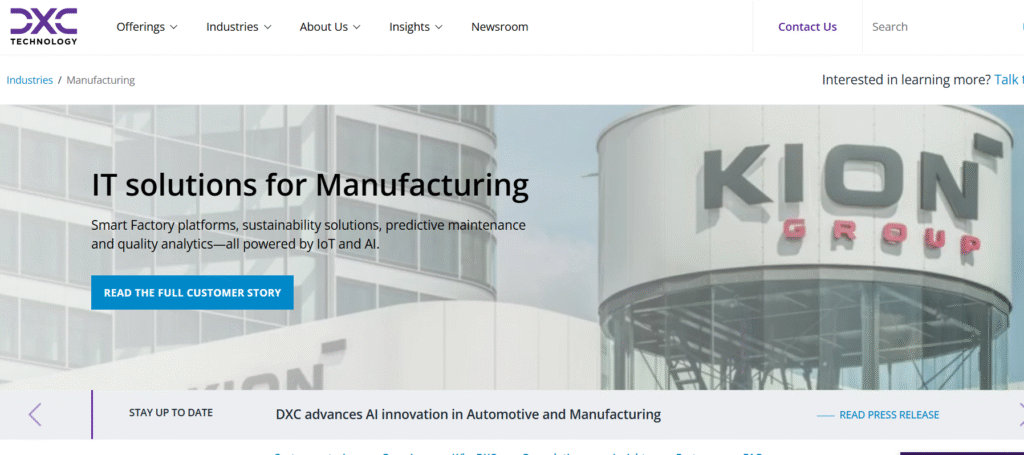
DXC delivers comprehensive manufacturing IT services, covering digital twins, cloud integration, IIoT analytics, and process automation.
A standout example is DXC’s collaboration with Ferrari, where they’re developing a next-generation digital cockpit interface powered by artificial intelligence, edge computing, and high-performance data management. DXC also helps manufacturers implement predictive maintenance, quality analytics, and cybersecurity for production networks.
The result: reduced downtime, lower costs, and higher productivity. For companies seeking world-class manufacturing IT services, DXC sets the benchmark for merging innovation, data, and engineering precision into one seamless digital ecosystem.
Feature: DXC collaborates with AI startups. For example, with CAMB.AI for automated weld seam inspection. The system uses computer vision and detects defects that humans might miss. One auto plant reduced defective parts by 35%.
2. Siemens Digital Industries (Germany)
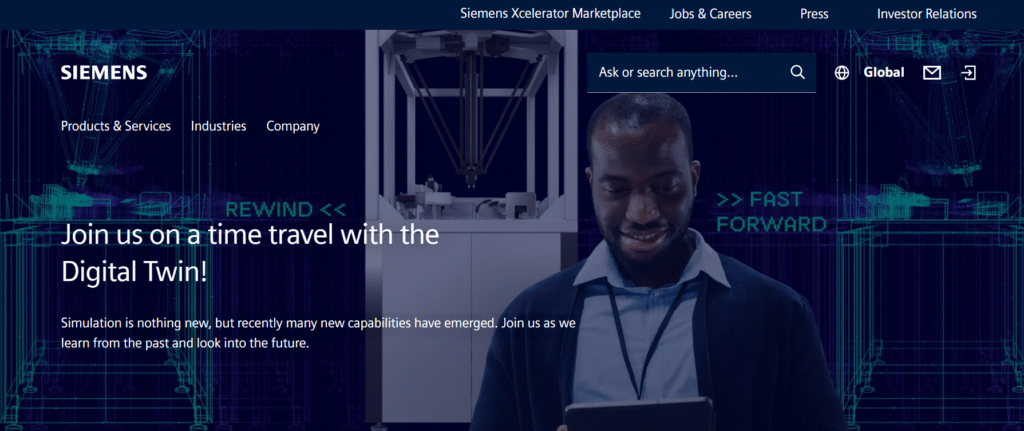
If anyone deserves the title “veteran of digitalization,” it’s Siemens. Their Tecnomatix and Opcenter solutions cover the entire production cycle, from planning to execution.
Most interesting: the digital twin platform allows simulating an entire factory even before the first foundation is laid. One German automotive company used this to optimize a new line. Result: 30% time savings on production launch and 20% reduction in energy costs. No wonder Siemens works with half of the Fortune 500.
3. GE Digital (USA)

GE Digital believed in smart factories before it was cool. Their Proficy Smart Factory platform runs production like a conductor leading an orchestra – everything synced, smooth, and data-driven. It constantly reads sensor data and tweaks the process in real time.
One pharma plant that adopted it boosted efficiency (OEE) from 65% to 85%. Basically, they gained three extra hours of productive time every day without hiring anyone new. Not bad for what used to be “just software.”
4. PTC (USA)
PTC mixes IoT and augmented reality in a way that makes factories feel a bit futuristic. Their ThingWorx platform connects all the machines into one smart network, while AR tools help technicians fix complex equipment like pros.
One aircraft engine manufacturer tried PTC’s AR glasses for training – and suddenly, six months of onboarding turned into just three. You put on the glasses, and instructions appear right on the machine, step by step. It’s like a video game tutorial, except the “win” is shaving months off training and saving serious money.
5. Dassault Systèmes (France)
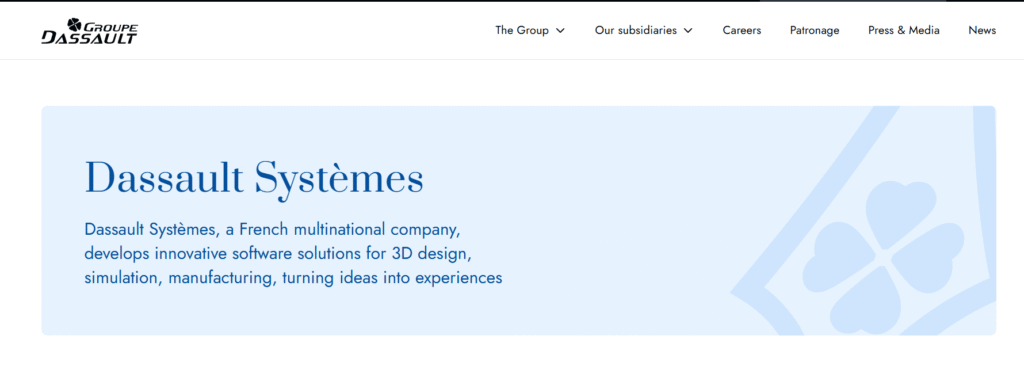
The French have always had a taste for elegant solutions. Dassault’s 3DEXPERIENCE platform is a comprehensive approach to PLM (Product Lifecycle Management) and production planning.
Coolest feature: the DELMIA module allows planning the work of robots and automated lines in 3D. One electronics manufacturer used this to optimize 50 robots on a line. After simulation, productivity increased by 40%, and collisions between robots dropped to zero. Previously, robots would sometimes “fight” like Pokémon in an arena.
6. Rockwell Automation (USA)
Rockwell does what’s called “edge computing” for industry. Their solutions process data directly at production sites, without sending everything to the cloud. This is critically important when milliseconds matter.
Example: a beverage manufacturer implemented a Rockwell system for bottle quality control. AI cameras check each bottle for defects at a speed of 1,200 bottles per minute. Defect detection accuracy: 99.7%. The human eye gets tired after an hour; AI can work 24/7 without coffee.
7. Fanuc (Japan)
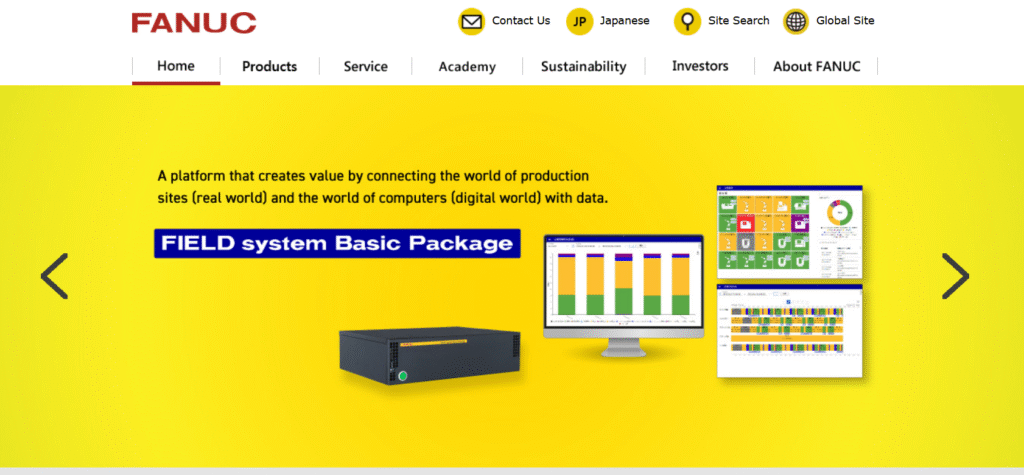
The Japanese have been making robots since 1956, so they know everything about automation. Fanuc specializes in industrial robots with machine vision and AI.
Interesting detail: their robots learn from each other through the cloud. If one robot at a factory in Tokyo learns the optimal part grip, all other Fanuc robots worldwide receive this knowledge. It’s collective intelligence, like the Borg from Star Trek, but without assimilation.
8. ABB (Sweden/Switzerland)
ABB has turned the idea of robots in factories into something surprisingly human. Their cobots – collaborative robots – don’t hide behind safety cages, they literally work next to people.
Imagine this: an electronics worker places a circuit board, and the ABB robot carefully solders the parts in place. No drama, just smooth teamwork. The result? A 60% boost in productivity and way less fatigue for the operator, since the repetitive stuff is handled by the bot. It’s not science fiction – it’s what happens when automation finally learns to play nice with people.
9. Bosch Rexroth (Germany)
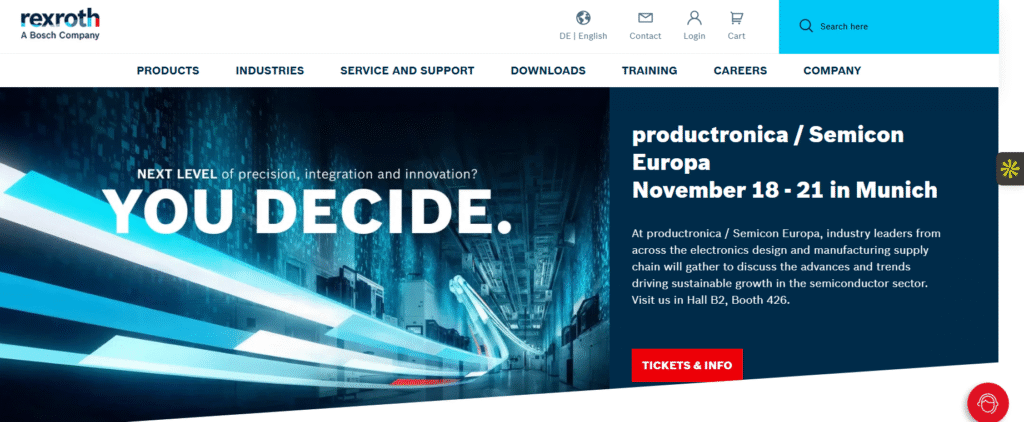
Bosch makes solutions for connecting “old” machines to modern networks. Their ctrlX AUTOMATION concept is an open platform that can work with equipment from different manufacturers.
Case: one factory had equipment from five different manufacturers, and no system communicated with another. Bosch created a unified platform that brought everything together. Now operators see all data in one place. It’s like switching from five remote controls to one universal one.
10. Microsoft + Industrial Partners (USA, global)
Microsoft doesn’t manufacture machine tools, but their Azure cloud and AI tools have become the foundation of many solutions. An interesting trend: Industrial Copilot—an AI assistant for manufacturing.
Concept: an operator can ask a chatbot: “Why is line 3 running slower?” The system analyzes data from hundreds of sensors and gives an answer: “Compressed air pressure dropped by 10%.” It’s like ChatGPT, but for factories. One chemical manufacturer implemented this and reduced problem-solving time from hours to minutes.
What This All Means for Manufacturers
If you’re still reading, the topic has struck a chord. And rightly so, because the stakes are high. Companies investing in manufacturing software solutions get concrete advantages.
- Flexibility: you can quickly reconfigure production for new products. In the age of personalization, this is critical. Customers want customization, and whoever can provide it faster wins the market.
- Efficiency: AI-based systems optimize every step. Less waste, less energy, more output. One company reduced energy consumption by 25% simply through better planning via a digital twin.
- Quality: automated control detects defects that the human eye misses. This is especially important in automotive, aerospace, and medical equipment, where mistakes cost lives.
- Sustainability: ESG (Environmental, Social, Governance) is no longer a buzzword but a market requirement. Monitoring systems help track emissions, waste, and resource consumption. Investors look at these metrics.
- Competitiveness: in a world where innovations appear monthly, falling behind by a year means death. Manufacturing IT services provide the opportunity to experiment quickly and cheaply through digital simulations.
Looking to the Future
What will happen in five years? Generative AI will start designing optimal parts independently. Quantum computers will solve supply chain optimization problems in seconds. Robots will become so smart they can independently learn new operations without programming.
In ten years, the line between physical and digital manufacturing will blur. The digital twin won’t be a copy of the factory, it will become its brain. Decisions will be made automatically based on millions of parameters.
But most interesting: humans won’t disappear from manufacturing. On the contrary, the role changes from routine executor to creator and controller. Technicians become robot “trainers.” Engineers become architects of digital ecosystems.
Conclusion: The Revolution Is Already Here
The fourth industrial revolution isn’t somewhere on the horizon. It’s happening right now. Digital twins, AI, IoT, robots, cloud computing, GenAI, all of this is already working in real factories.
Companies seeking competitive advantage invest in IT solutions for manufacturing industry not because it’s fashionable, but because survival depends on it. The market won’t wait. Customers won’t wait. Competitors definitely won’t wait.
Those building digital factories now will dominate the market in five years. Those waiting will become history, like Nokia, which missed smartphones.
The question isn’t whether to invest in digital transformation. The question is how much time you have before competitors overtake you so far that catching up will be too late. The answer is simple: there’s less time than it seems.









